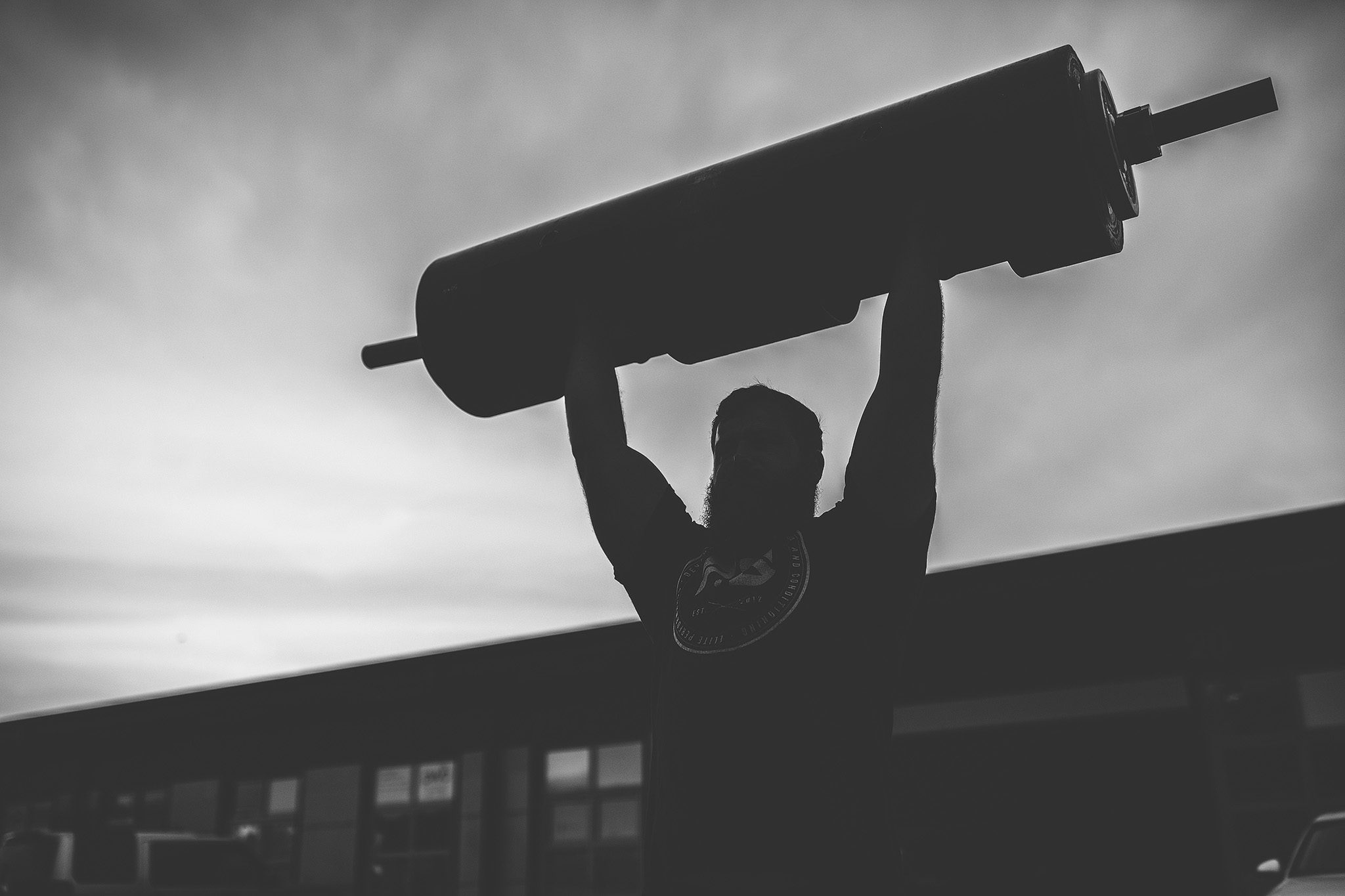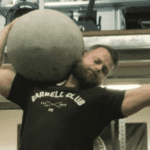Strongman Training for The Everyday Athlete

If you’ve ever seen clips of a strongman competition in which an absolute unit is heaving a massive concrete boulder onto a platform, you know how insane and badass it looks. Those guys and gals clearly have a level of superior functional strength that most athletes can benefit from. So what strongman style lifts should you start with if you want a taste of that glory?
Jordan Devanney a 10-year S&C coach with UK weightlifting champions and record holders in events like the Circus DB, Atlas Stone and Junior Deadlift (even Britain’s Strongest Female Police Officer!) — he owns Devanney Strength where he works with athletes of all ages and skill levels. Read on to learn his top 3 strongman lifts to get you started.

Change the Way You Train
Strongman Style: Dragging Trucks & Throwing Boulders
The athletes need to have a comprehensive base of physical fitness and strength, which is what makes strongman training so unique and fun. Their workouts can include pulling trucks, carrying sandbags, deadlifting odd objects, pressing giant logs overhead, or walking while carrying heavy weights in each arm.
It’s not unusual to have mystery events where athletes just have to figure it out on the fly.
Being based in the UK, it’s quite a tradition for us to watch strongman competitions on TV over Christmas. As a kid, I was always in awe of these freakishly large characters pulling planes and throwing boulders onto platforms.
Now I run a strength and conditioning studio in the UK specializing in strength sports. We recently broadened our horizons to include more casual athletes, including the elderly population. I program some simple strongman movements for every single one of our clients and we’ve seen fantastic results — not only in their strength and fitness, but also in their confidence in themselves.
Strongman training is the real deal. It builds that raw, old-school brute strength and challenges you with unconventional movements. Everyday athletes have a ton of gains to make by including some strongman lifts in their training.
Who Is Strongman For?
Answer: YOU! The beauty of strongman is its versatility. I have clients in their 70s using exercises like farmers’ carries to develop grip strength and the fitness to feel confident carrying things on their own.
We also have a variety of high-level athletes using strongman-based practices to develop savage strength. Unlike anything else we’ve done, this consistently gives them an edge over their opponents.
The key is planning how much load to use with exactly which exercises. Because of its functional nature, pretty much anybody can implement strongman work into their programming.
The Massive Benefits of Strongman Training
Strongman work has a ton of benefits most people don’t realize — weight loss, increasing cardiovascular fitness, increasing muscle mass, developing real-world functional strength, and challenging your ideas on how workouts should feel.
Developing Functional Strength
Functional strength is your ability to move heavy or awkward objects like you might have to do in everyday life. This means being able to pick up, carry, pull, push, throw or otherwise move a load by yourself. This is strongman; this is literally the foundation of what it’s all about.
I also believe that to be truly functional and strong, you need to have a side of conditioning. So yeah, being winded after three reps is useless when it comes to real-world functionality. You need the fitness to back up your strength if you want to keep making athletic gains.
Pushing Through Training Plateaus
Plateaus happen to everyone eventually. Your progress can stall for a number of reasons, but often it’s from overly repetitive training methods. Over time your body gets used to a consistent stimulus. To overcome this, you must provide your body with a new stimulus to spark further progress. The unfamiliarity of strongman lifts will force you to set new levels of adaptation.
Increasing Muscle Mass & Bone Density
One of the critical elements of developing muscle mass is time under tension. A lot of strongman exercises will have you moving into higher rep ranges, which is excellent for building muscle tissue. For movements like sled pulls and carries, your muscles will be under tension the entire time for whatever distance you’re lifting.
There’s also a positive correlation between the effects of resistance training and bone density, which is one of my main reasons for programming strength training for elderly clients. This is especially true for the elderly female population, who are most likely to be at risk of osteoporosis.
Improving Trunk & Grip Strength
This is one of the biggest benefits, particularly with the “moving” events. Stabilizing muscles of your trunk are forced to keep your spine from wobbling while you move with a heavy object. This helps develop excellent stability through your entire trunk.
I like traditional gym equipment — strongman carries require you to hold onto dumbbells and kettlebells with your hands. But even better, we often use odd objects with different grip types like open-hand grip, pinch grip, and fat grip. This variety helps develop phenomenal grip strength.
Boosting Cardiovascular Fitness (Really)
Performing reps within a given timeframe really gets your heart rate up, as does one of my favorite strongman movements, the sled pull. If you’ve ever tried dragging a weight over any amount of distance, you know how quickly it can set your lungs on fire.
For sled pulls in particular, your heart and lungs are forced to provide oxygen and blood to big working muscles over an extended period of time. I love using sled pulls to develop my athletes’ engines.
Reminding You That Fitness Is Fun
For me, this is really important. I think it’s an underappreciated part of training, especially when it comes to following a regular program. One of the factors I notice in people who fail with their health and fitness goals is the lack of consistency over time. Often this is due to associating training with a chore.
Focusing on fun once in a while means the athlete will look forward to their sessions, so they’re more likely to keep it up for the long term. Throwing around big sandbags, dragging heavy sleds or moving odd objects can all be fitness for fun.

Top 3 Strongman Exercises For Everyday Athletes
These lifts are the three I most commonly use with my clients, and I’ve put them in the order I’m most likely to use them. Strap in as I go through how to set yourself up for each exercise and how to program them into your training depending on your goals.
1. Farmers Carry
I believe it was weightlifter and Highland Games athlete, Dan John, who said, “If weakness was a disease, farmers’ carries would be the cure.” I wholeheartedly agree. If you’re trying to pack on slabs of muscle, improve your strength, and build a phenomenal engine, farmers carries (also called farmers walks or loaded carries) might be your next favorite training staple.
All you need to perform a farmers walk is two equal-weight objects ideally with handles. You can use a trap/hex bar or even better, farmers carry handles that can be loaded with plates. If your gym doesn’t have these things, a pair of heavy dumbbells or kettlebells will work. The world is your oyster when it comes to picking the objects you carry.
How To Do Loaded Farmers Carries
Set up your weights of choice on the floor outside of your feet. Perform a sort of hybrid squat-hinge to grip the handles, then take a breath to brace your trunk. Set your back tight and press into the floor as you stand up with the weights, nice and cool. Then you just walk forward, keeping your spine neutral, shoulders even and gaze towards the horizon.
Breathing can feel tricky when moving with all that weight, so I advise breathing from pursed lips to keep a solid core brace while you walk.
Programming for Strength
Perform heavily loaded carries up to 20 meters before putting them down and taking a rest.
Do 3-5 sets.
Programming for Fitness
Select a weight between 25-50% of your best carry for 50-200 meters. Then put them down, take a 30-second rest and repeat 10 times. You could also do it for a given time frame, say a 10-minute AMRAP (as many rounds as possible).
Programming for Mental Grit
This is a fun challenge — load up 25-30% of your best carry and walk for as much distance as you can manage. Once you’ve reached your absolute limit with your grip, rest for 3-5 minutes, then try to get them back to the gym in one or two walks.
2. Sled Drags
Sled drags are one strongman exercise that I think everyone should be doing regularly. No other piece of equipment on Earth can build a dog-like mentality like the prowler can. The reason I love the sled is that there is no eccentric part of the movement, so it generally yields low muscle soreness. It also has a short learning curve, so unlike a barbell back squat, dragging a sled is a pretty straightforward movement to pick up.
One of the main benefits I see from sled drags is improved work capacity and conditioning. The sled will also develop your leg and core muscles, along with your back and forearms depending on your grip. You can really vary the movement — drags can also be done with a belt around the waist, both forwards and backwards.
How To Do Sled Drags
Load your desired plates on the sled and grasp the handles, or place a belt around your waist for reverse drags. For a forward drag, position the tow rope behind you; for a backward drag, grab the handles in front of you. Brace your core and lean into the walk. The heavier the sled, the more you’ll need to lean your body weight into the movement. Keep your shoulders set, don’t let them round, and think about driving your feet into the ground.
Programming for Strength
Load your sled up heavy and perform drags over a distance of 20 meters aiming to be as aggressive as possible in each step. Rest 2-5 minutes between each set for 4-6 sets.
Programming for Fitness
Load your sled up about 50%, then drag for a certain distance on the minute every minute for a given time frame. For example: 30 meters every minute on the minute for 15 minutes. Your rest time is how much time you have left after you’ve completed the 30 meters. You can also perform drills like 10, 20, 50, and 100 meter sprints.
Programming for Mental Grit
Another favorite of mine for testing mental fortitude — we call it The Murder Mile. Drag the sled for one mile. There’s no time limit; you just have to get it done. When selecting load for the murder mile, 30-60% range seems to be the best. Much higher than this and you might just get stuck, which sort of defeats the objective. If any of you embark on this, please let me know how it goes!
3. Atlas Stone Or Sandbag Lifts
For thousands of years, heaving boulders is how men sought to prove their strength and lifting prowess. The stone is raw, unwieldy, requires a ton of grit and determination — it’s entirely different to any of your regular gym lifts. The Atlas stone is my favorite of all the strongman exercises, primarily due to its thousand-year-old history. You can still find natural lifting stones in strongman competitions, especially in places like Scotland and Iceland.
So what are the benefits of lifting the stones, other than proving your worthiness and gaining your chance to enter Valhalla? Stones are excellent for developing strength and size in the glutes, hamstrings and upper back, but the main benefit is to be strong in awkward and potentially vulnerable positions. The stone will expose your body to resistance in positions that aren’t typically tested with barbell movements. This actually translates to high-impact sports such as rugby or combat sports, since you can develop robustness in dynamic stances.
You must have some lifting ability before starting with the stones. As a rule of thumb, I like my clients to be able to perform deficit deadlifts with at least their body weight before we tackle Atlas stones. This is to ensure they have developed the muscles of their lower back sufficiently.
Since many traditional gyms don’t have Atlas stones, you can use a sandbag instead. They even make big, round sandbags to mimic the size/shape of stones.
How To Lift an Atlas Stone or Sandbag
Step up to the stone and crouch down with your hands around the center to ensure that you’re balanced. The stone will try to roll away as you break it off the floor. Splay your fingers wide as you wrap your arms around the center of the stone and squeeze like you’re trying to break it in half (like a big hug). You must maintain this squeeze throughout the deadlifting phase.
Now you need to deadlift the stone off the floor and get it past your knees. Deadlifting the stone is closer to an RDL than a traditional deadlift due to the unwieldy nature of the stone. You must use your hamstrings and hips to break the stone off the floor. Your upper back might round a little, but that’s ok. Once you pull the stone past your knees, you’ll sit in a front squat position with the stone resting on your thighs.
Adjust your grip from around the sides to over the top of the stone into a 10 and 2 position. In order to launch the stone up onto a loading platform, you’ll need to drive your hips forward explosively, like you would for a power clean. Roll the stone up your body and set it on the platform once you hit full extension and the stone is as high as you can get it.
If you’re not using a platform, the stone or sandbag is considered stable once it rests on one shoulder. You can also toss a heavy bag over one shoulder every rep or try flipping it over a rig. Be sure to drop your stone or bag onto some thick rubber matting to save your floors.
Hella Inspo: Check out Dani Speegle’s EPIC 250lb sandbag lift at the Crossfit Games this year. It was an electric moment!
Programming for Strength
To program the Atlas stones for strength, perform 3 sets of 3 reps to a platform equal to at least 2/3 of your height. Traditionally this would be done with between 75-90% weight or 8-9 RPE. If you’re just beginning, start with a much lighter stone so you get a good feel for this type of movement.
Programming for Fitness
For general fitness, choose a lighter bag/stone (around 30% with more experienced individuals; up to 60%). Perform as many repetitions in a given timeframe as possible. For example, AMRAP in 60 seconds followed by 60 seconds rest repeated 5 times.
Programming for Mental Grit
Switch it up to develop serious mental grit and carry the stone for a distance. I like to program something along the lines of 250-500 meters or up to 1000 meters if you’re feeling crazy. When doing this, I set a distance and try to do it with the fewest drops possible.
Both farmers carries and sled work can easily be incorporated into almost anyone’s fitness regime, regardless of their current fitness and strength levels. It’s simple enough to learn how to carry and drag light weights.
Atlas stone lifts are number three because they require good mobility and access to the equipment, as well as sufficient strength before you can start using stones safely. When in doubt, call on a coach to help you refine the lifts.
Next time you’re feeling stuck or bored with your training, I hope you’ll give some of my favorite strongman events a try. Start with the programming for fitness and just do one or two movements a week.
I guarantee as you build up over time, the lifts will become natural and fun, making you feel like a total beast in the process.
Find Your Perfect Training Plan
Sometimes all you need to reach your destination on your fitness journey is an expert guide. We've got you covered. Browse from thousands of programs for any goal and every type of athlete.
Try any programming subscription free for 7 days!
Want Training Tips, Exercise Guides & Knowledge Bombs Sent to Your Inbox?
Sign up for the FitNerd newsletter from TrainHeroic
Related articles
3 Ways to Improve Mobility Without Stretching
Are you still trying the endless foam rolling and stretching exercises to get that deep squat position? We know how important mobility is for great, or even GOOD performance. All professional athletes have some comfortability in end ranges of motion. So, what else do...
The Ultimate Guide to Lunges: Queen of all Glute Exercises
Your glutes are the largest muscle group in your body. They’re responsible for almost everything your legs do—walking, running, jumping, squatting, lunging, and just standing upright. As far as moving through space goes, strong glutes are the bedrock of overall...
A Beginner’s Guide to Steel Mace Training
Author: Jesse Grund
Mace training will make you a better mover without it’s not confining you to a fixed space or predetermined range of motion. Second, it’s an offset load with 80 to 90 percent of the weight in the head. You’re also constantly having to resist rotation, which creates greater core engagement.

Join the community
Sign up for the latest training news and updates from TrainHeroic

About TrainHeroic
Made with love, sweat, protein isolate and hard work in Denver, CO
© 2023 TrainHeroic, Inc. All rights reserved.






